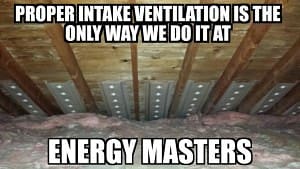We install attic insulation, wall cavity insulation, batt insulation and ventilation baffles.
Improving the comfort of your home while reducing your energy bills is our focus. We aren't interested in just selling you as much insulation as possible. At Energy Masters, our ventilation certified tech can optimize ventilation and make recommendations that can help reduce your energy bills.
 Why is ventilation important?
Why is ventilation important?
Here in Wisconsin we have freezing temperatures and as such, the ends of the nails that hold your shingles on often stick through your roof decking and into your attic space. If you don't have proper ventilation, moisture from your home builds up on those nails and when the temperature of the attic cavity increases, the condensed moisture can drip down onto your insulation, causing mold. This can exacerbate allergies and contribute toward asthma.
Our "Healthy House" Approach
Our goals for insulation are two fold:
We use long-fiber insulation whenever possible, which means it doesn't itch like many of the products out there.

Common Insulation Questions:
Why blown in?
Batt insulation is great for walls, but results in gapping which creates cold spots on the drywall on your ceiling. That leads to condensation and condensation often leads to mold. Blown in insulation solves that problem by providing a constant sheet of insulation over what is called the energy envelope of your home.
Will my insulation settle?
We use a special type of long-fiber insulation that does not settle. This assures you of having a well-insulated attic for decades to come.
Wall insulation
Blowing insulation between your wall cavities is sometimes the best or only practical option. Houses built prior to the 1970's didn't always have insulation between the walls and if they did, sometimes the insulation was either insufficient or it has settled.
How much should I have blown in?
How much you choose to have blown in depends on your personal preference as well as your budget. We can blow in as much or as little as you wish. The Environmental Protection Agency recommends that you put between R-49 and R-60 in your attic.
Will you blow in insulation in all cases?
No. When we visit your home we assess your property. We will look in your attic space and look at how your house is both insulated and ventilated. There are some cases where blowing in insulation will just make your problem worse and if that's the case we will tell you and provide you recommendations to solve the problem. Like a doctor, our approach is to "first do no harm". If we can't fix a problem, we won't take the job.
Can you blow in insulation on top of existing insulation?
In most cases yes. However, if your house contains vermiculite, a product containing asbestos, we recommend you find a company that does remediation and removal. Vermiculite tends to look like it has little specks of tinfoil in it. Ethics prevent us from taking jobs where both our crews as well as homeowners are exposed to dangerous substances.
 Who will stop by?
Who will stop by?
Jim, the owner of Energy Masters, is ventilation certified. He will inspect your home and make suggestions to improve it
Jim specializes in solving problems other companies don't have the background to understand.
The Energy Masters System:
We’ll look at your house and assess it’s needs. We will make recommendations based on a variety of factors:
After we assess your property, we’ll make our recommendations. Sometimes those recommendations are to do nothing. If that’s the case, we’ll tell you.
Would you rather invest in insulation once...
...Or pay more money to the utility company every month?
Learn More about Insulation
5 Reasons your Windows have Condensation
When the weather turns cold, many homeowners experience condensation on their windows and in some cases, on their walls. Ventilation This is an issue of ventilation and/or insulation. However, insulating without a solid understanding of the building sciences could make things worse or even contributing toward mold growth. The last thing you want to do…
Basement Air Sealing a Money Saver
One of the most often neglected parts of insulation are the rim joists — that cavity in basements where the floor meets the concrete wall. There are a couple options for insulating rim joists. Traditionally, homeowners pack them with batt insulation. Rock wool or fiberglass are the most common types of insulation used for these…
What type of Insulation is the Best?
There are three types of insulation that are being used in today’s market. The well informed homeowner understands there are pros and cons of each of them and here’s what they are: Settling: Most insulation settles and since it settles, it means you will have a lower R-value. (R-value refers to resistance to temperature changes. The…
Understanding Ice Damming
In late winter I get many calls from people asking me if I could put new gutters on their houses to solve their ice damming problems. I have to be honest with them and explain that ice damming is a product of ventilation and insulation gutters won’t fix their ice damming problems. It may not be good for business,…

